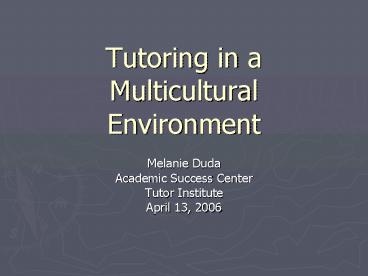Tutoring in a Multicultural Environment - PowerPoint PPT Presentation
1 / 11
Title:
Tutoring in a Multicultural Environment
Description:
Discuss relationship between multiculturalism and tutoring ... Gay, lesbian, bisexual, and transgender students. Non-traditional students ... – PowerPoint PPT presentation
Number of Views:80
Avg rating:3.0/5.0
Title: Tutoring in a Multicultural Environment
1
Tutoring in a Multicultural Environment
- Melanie Duda
- Academic Success Center
- Tutor Institute
- April 13, 2006
2
Welcome
- Objectives
- Become more aware of culture and its role
- Discuss the importance of multiculturalism
- Discuss relationship between multiculturalism and
tutoring - Learn strategies to improve tutoring in a
multicultural environment - Awareness of personal biases
- Communication skills
- Ways to learn about others
3
What is Culture?
- Tyler (1871) that complex whole which includes
knowledge, belief, art, law, morals, custom and
any other capabilities and habits acquired by man
as a member of society. - Contemporary A set of standards (e.g. values,
morals, ideals) shared by the cultures members
which, when acted upon by members, produce
behaviors that fall within a range of variation
that the members consider proper and acceptable.
Haviland 1997
4
Characteristics of Culture
- Universal
- All human societies have culture
- Shared
- Members agree to values, beliefs, and behaviors
- Learned
- Process of enculturation, diffusion
- Patterned
- Set of behaviors characterize groups
- Unconscious
- Individuals embedded, culture taken for granted
- Variable
- Worldwide differences, individual differences
Haviland 1997, Ember and Ember 1993
5
Cultural Variation
- Cultural values differ worldwide
- Food, dress, rituals, social roles, health,
education - Individuals also perceive culture differently
- Subcultures
6
Important Distinctions
- Society A group of people who occupy a specific
location and may share common cultural
traditions. - Ethnicity The notion of shared nationalistic
origins and shared cultural values reflected in
societal classifications, created when one group
of people assumes an identity different than
those with whom they share borders.
Haviland 1997, Loustaunau and Sobo 1997
7
What is Multiculturalism?
- The Multicultural Perspective
- A lifelong commitment to and active engagement in
the process of seeking effective and respectful
interactions with members of diverse populations - Linked to cultural humility
- Self-critique and evaluation to understand
personal attitudes toward others assessment of
the cultural dimensions of the experiences of
individuals flexibility to understand what is
not known and to seek new information
Tervalon, et al 1998
8
Why is Multiculturalism Important?
- College/university populations are diverse
- Wayne State demographics
- 19,553 Women
- 13,781 Men
- 8,788 African Americans
- 137 American Indian/Alaskan Natives
- 764 Latino
- 16,694 White
- 2,208 Undeclared
http//www.wayne.edu/profiles/student.html
9
Why is Multiculturalism Important?
- 2,783 International students
- Canada
- India
- China
http//bog.wayne.edu/meetings/2006/01-25/academica
ffairs0106-itemq.pdf
10
Why is Multiculturalism Important?
- The world is becoming increasingly globalized
- The population of immigrants in the US is rising
- By 2050, 13 of Americans will be foreign born
- Universities are comprised of diverse populations
- Multiple ethnicities
- Students with disabilities
- Gay, lesbian, bisexual, and transgender students
- Non-traditional students
- Differential socioeconomic status
- Athletes
- Musicians
- Students in different majors
11
Perceptions of Others
- Culture is pervasive
- It is difficult to see through the eyes of the
other - This causes difficulties in cross-cultural
interactions - Ethnocentrism
- Bias
- Poor communication
- Unsatisfactory results































